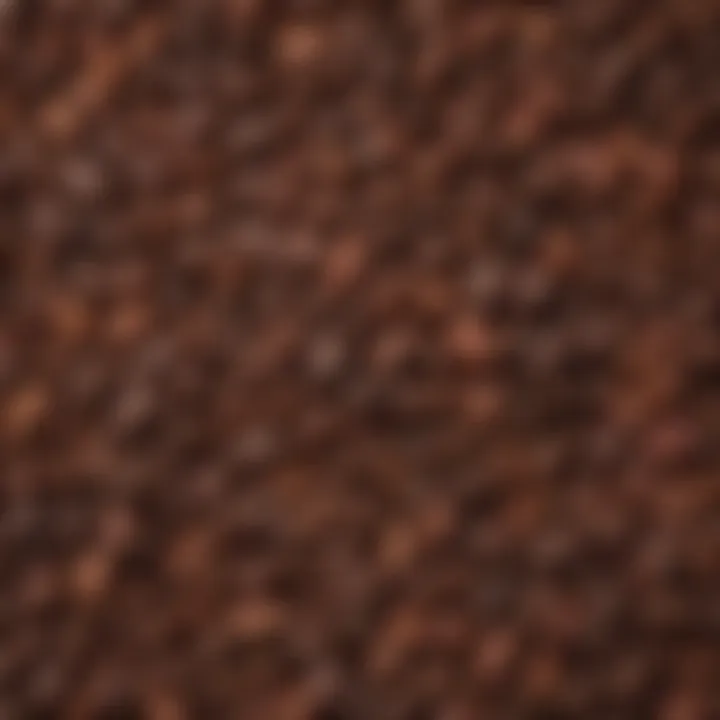An In-Depth Exploration of Dark Chocolate's Richness


Intro
Dark chocolate, often celebrated for its rich flavor and numerous health benefits, has a storied history that dates back centuries. Believed to originate in Mesoamerica, ancient civilizations like the Mayans and Aztecs revered cacao. They used it in rituals and as currency. Over time, the transformation from a bitter beverage to the sweetened confection we know today reflects changes in taste preferences and cultural exchanges.
In contemporary culinary practices, dark chocolate has emerged not just as a delightful treat but also as a versatile ingredient in both sweet and savory dishes. Whether you are a gourmet chef or a home cook, understanding the nuances of dark chocolate can elevate your culinary creations.
This article explores the multifaceted world of dark chocolate. It delves into its health benefits, elaborate production processes, and culinary applications. We will also discuss the distinct flavors that different cacao varieties offer. Additionally, we will cover the cultural significance of dark chocolate across various cuisines, enriching your appreciation for this sophisticated ingredient.
"Dark chocolate’s complexity goes beyond taste; it’s an intersection of culture, health, and culinary artistry."
Recipe Overview
- Recipe Name: Dark Chocolate Ganache
- Brief Description: This rich and smooth ganache can be used as a filling for pastries, a topping for desserts, or simply enjoyed on its own. Its simplicity highlights the quality of the dark chocolate employed, making it a choice for both novice and experienced cooks alike.
Prolusion to Dark Chocolate
Dark chocolate has become increasingly popular over the years. Its allure stretches beyond its rich flavor; it encompasses the realms of history, health benefits, and culinary versatility. This article aims to unravel the intricate tapestry of dark chocolate, placing significance on its definition, varieties, and the role it plays in contemporary diets. Understanding dark chocolate is essential for anyone seeking to appreciate its multiple dimensions. It stands out as a sophisticated ingredient that appeals to both palate and mind. This section introduces essential concepts that will pave the way for a deeper exploration.
Definition and Composition
Dark chocolate is primarily composed of cocoa solids, cocoa butter, and sugar. Unlike milk chocolate, it does not contain milk solids, leading to a more intense taste. The higher the cocoa content, the less sweet and more aromatic it becomes. Standard percentages found in dark chocolate can range from 50% to 90%, but some varieties might have even higher cocoa content.
Key components of dark chocolate:
- Cocoa Solids: These are responsible for most of the texture and flavor. They are rich in flavonoids, which contribute to health benefits.
- Cocoa Butter: This fat creates a creamy mouthfeel. It is stable at room temperature and plays a crucial role in chocolate’s melting properties.
- Sugar: While some dark chocolate has high cocoa content, sugar is added to balance the bitterness.
- Lecithin: Often used as an emulsifier, it helps blend the cocoa butter with solids, giving chocolate a smoother texture.
Understanding these components illuminates how dark chocolate is crafted and what makes it unique compared to other types of chocolate. Consumers and culinary enthusiasts must consider these elements when selecting dark chocolate, as they significantly impact both flavor and texture.
Varieties of Dark Chocolate
The landscape of dark chocolate is vast, with numerous varieties available to consumers. Each type varies in flavor profile, texture, and even color, influenced by the origin of the cacao beans and processing techniques.
Common varieties include:
- Bittersweet: This type is often used in baking. It has a rich flavor and generally contains 60-70% cocoa.
- Semisweet: Though primarily used in baking, semisweet chocolate is also enjoyed as a snack. It typically contains 50-60% cocoa.
- Unsweetened: Pure chocolate, often used in professional baking, contains no added sugar. It usually has 99% cocoa solids and a very intense flavor.
- Single Origin: Sourced from a specific region, single origin chocolate offers unique flavor profiles based on the terroir.
- Raw Chocolate: Made from unroasted cacao beans, this variety retains more antioxidants but has an earthier taste.
By familiarizing oneself with these varieties, consumers can better navigate their choices, enhancing their culinary experiences with dark chocolate.
The Historical Context of Dark Chocolate
The historical background of dark chocolate is not just a tale of indulgence. It reveals the complex relationships of societies with cacao through the ages. Understanding this context enriches our appreciation of dark chocolate today. From its celebrated origins to its evolution in Europe, each phase tells a story of cultural significance and culinary innovation.
Ancient Civilizations
Dark chocolate traces its roots back to ancient Mesoamerican cultures, mainly the Olmec, Mayan, and Aztec civilizations. These early societies revered cacao, which was not simply a food but a sacred component of their rituals. Cacao beans were often used as currency. They were so valuable that there are instances of people paying taxes with them.
The Maya consumed a drink made from cacao, often flavored with chili and other spices. This beverage was associated with nobility and was part of important ceremonies. The Aztecs, on the other hand, viewed cacao as a gift from their god Quetzalcoatl. Their leaders drank it before battles and special occasions, adding fiery spices to enhance its flavor and potency.
The European Adoption
The arrival of cacao in Europe marked a significant shift in its use and perception. In the 17th century, cacao made its way to Spain, primarily through the marriage of Anne of Austria and King Louis XIII. Initially, it was only enjoyed by the aristocracy. The drink soon evolved with the addition of sugar and cinnamon, making it more palatable to European tastes.
Chocolate houses emerged in England and France, where it became a social drink among the upper classes. By the 18th century, dark chocolate found its way to the masses. The invention of the steam engine and advances in processing techniques made chocolate accessible to a larger audience.
Today, dark chocolate continues to symbolize sophistication. It is deeply ingrained in many culinary traditions. As we explore its past, we see a narrative of connection, commerce, and cultural significance that endures in modern times.
"Cacao was more than a commodity; it was a lifeblood of ancient civilizations, woven into their rituals and social structures."
This rich history underpins the enjoyment of dark chocolate today. In the following sections, we will further delve into its nutritional aspects and health benefits, continuing this fascinating exploration.
Nutritional Profile of Dark Chocolate


Understanding the nutritional profile of dark chocolate is essential for both culinary enthusiasts and health-conscious individuals. It provides insights into the benefits and components that make dark chocolate a valued ingredient. The profile is not just numbers; it's an integration of flavors, health advantages, and cultural applications. This section presents a detailed look at the caloric content, macronutrients, vitamins, minerals, and cocoa percentage, which all contribute to dark chocolate’s reputation.
Caloric Content and Macronutrients
Dark chocolate is known for its rich flavor, but it is also dense in terms of calories. The caloric content varies, generally ranging from 500 to 600 calories per 100 grams for varieties with higher cocoa percentages. This high caloric density comes mainly from fats and carbohydrates.
- Fats: Dark chocolate is primarily composed of fat, primarily from cocoa butter. Approximately 30-40% of dark chocolate's weight comes from fat, which includes both saturated and unsaturated fats. While some may be concerned about fat intake, these can promote heart health when consumed in moderation.
- Carbohydrates: Around 30% of dark chocolate's weight consists of carbohydrates, mainly sugars. The sugar content is lower compared to milk chocolate, adding to the appeal for those looking for a less sweet option.
Ultimately, dark chocolate can fit into a balanced diet when consumed wisely. Paying attention to portion control is vital, as the richness can lead to overeating.
Vitamins and Minerals
Dark chocolate serves as a good source of several vitamins and minerals, which enhance its nutritional profile.
- Iron: Important for red blood cell production, iron is abundant in dark chocolate. A typical serving can provide a significant portion of the recommended daily intake.
- Magnesium: This mineral supports muscle and nerve function. Dark chocolate can be a tasty way to boost magnesium levels in the body.
- Copper: Essential for forming red blood cells and maintaining healthy bones, dark chocolate provides a decent amount of copper.
- Manganese: Another mineral found in dark chocolate, it plays a role in bone formation and metabolism.
Important Note: While dark chocolate does contain valuable nutrients, it should not be seen as a substitute for other necessary food sources rich in vitamins and minerals.
Cocoa Percentage: What It Means
Cocoa percentage is a crucial factor when selecting dark chocolate. It indicates the amount of cocoa solids and cocoa butter present in the chocolate. The percentage can usually be found on the packaging. Higher cocoa percentages, often above 70%, are typically richer in flavor and contain more beneficial compounds, such as flavonoids, which are known for their antioxidant properties.
- 70% and Above: Dark chocolate of this level is often considered the healthiest. It provides a stronger flavor and greater health benefits due to the higher concentration of cocoa.
- 50-70%: This range often appeals to those who enjoy a balance between sweetness and cocoa intensity. However, it may have a higher sugar content than darker varieties.
- Below 50%: These chocolates are generally milder but may contain more sugar and fewer health benefits.
Understanding cocoa percentage helps consumers make informed choices based on taste preferences and nutritional content.
Health Benefits of Dark Chocolate
Dark chocolate is often celebrated not just for its rich flavor, but also for a range of health benefits. This section emphasizes the importance of understanding these advantages as they pertain to overall wellness and dietary considerations. Dark chocolate, particularly varieties with a higher cocoa content, is loaded with nutrients that can contribute positively to physical health and even mental well-being. Here, we will focus on several specific elements: the antioxidant properties, the impact on heart health, and the potential mental health benefits.
Antioxidant Properties
One of the standout features of dark chocolate is its high concentration of antioxidants. Antioxidants are compounds that can prevent or slow damage to cells caused by free radicals, which are unstable molecules that contribute to oxidative stress in the body. Studies have shown that dark chocolate is rich in flavonoids, especially catechin and epicatechin. These compounds help reduce inflammation and have been linked to better blood circulation.
A notable research found that consuming dark chocolate can increase antioxidant levels in the bloodstream. This increase can promote better health by reducing the risk of chronic diseases. To quantify this, research suggests that dark chocolate has a higher antioxidant capacity than many fruits, including blueberries and acai berries.
"Dark chocolate is not merely a treat; it's a potent source of antioxidants that can positively influence health."
Impact on Heart Health
In addition to its antioxidant effects, dark chocolate is known for promoting heart health. This benefit is primarily attributed to the ability of flavonoids to improve blood flow and lower blood pressure. Consumption of dark chocolate has been associated with a decrease in the risk factors for cardiovascular disease. It can help in lowering LDL cholesterol levels while increasing HDL cholesterol, which is often referred to as 'good' cholesterol.
Several studies have shown that individuals who consume dark chocolate regularly can experience a decline in blood pressure and improved heart function. The conclusion drawn from research indicates that moderate consumption—around 1 to 2 ounces per day—might support a healthier heart. It's important to remember that brands with higher cocoa percentages yield the greatest health benefits.
Mental Health Benefits
Dark chocolate may also cater to more than just physical health; it can provide important mental health benefits as well. Many people turn to dark chocolate for its potential mood-enhancing properties. This effect is thought to be due to the presence of phenylethylamine, a compound that can induce feelings of happiness and excitement.
Additionally, consuming dark chocolate may spur the release of endorphins, chemicals in the brain that produce positive feelings. One study revealed that regular dark chocolate consumption could be linked to decreased symptoms of anxiety and depression. While more research is needed in this area, incorporating dark chocolate into a balanced diet may contribute to an overall improved mood.
Overall, the exploration of the health benefits of dark chocolate reveals a compelling case for including it mindfully in our diets.
Production and Processing of Dark Chocolate
The production and processing of dark chocolate are essential to understanding its unique flavors and characteristics. This section examines the intricate journey from the cacao bean to the finished chocolate bar, emphasizing the techniques and considerations involved in each phase. The quality of dark chocolate is heavily impacted by the methods used, making this a significant topic in our exploration.
From Bean to Bar
The journey of dark chocolate begins with the cacao bean, which is harvested from cacao trees. The fermentation process follows, where the beans are placed in pods and covered with leaves for several days. This critical step develops the beans’ flavor compounds. Once fermented, the beans are dried, roasted, and cracked open to separate the nibs from the shell. This is where the magic begins. The nibs are ground into a liquid known as chocolate liquor, which is then further processed to create dark chocolate.
The next stages involve conching and tempering. Conching is the process where the chocolate liquor is continuously mixed to improve its texture and flavor. Tempering stabilizes the chocolate, giving it a smooth finish that is crucial for both flavor and appearance. These steps not only enhance the sensory qualities of dark chocolate but also influence its melting point and snap. The entire process highlights the complexity of producing quality chocolate, where any misstep can lead to subpar results.


Ethical Sourcing and Sustainability
In recent years, ethical sourcing has become a vital aspect of chocolate production. Many chocolate manufacturers are now prioritizing traceability and sustainability in their sourcing practices. This means ensuring that cacao beans are sourced from farms that pay fair wages and follow environmentally friendly practices.
Sustainable practices include avoiding deforestation and supporting local communities. By choosing ethically sourced chocolate, consumers contribute to fair trade initiatives that empower farmers. The impact is significant, not only ensuring better living conditions for those who cultivate cocoa but also promoting responsible farming methods that preserve biodiversity.
"Sourcing cacao ethically is not just a trend, but a necessary evolution in the chocolate industry, promoting fairness and sustainability."
Culinary Applications of Dark Chocolate
Exploring the culinary applications of dark chocolate is essential for understanding its versatility and influence in various cuisines. Not only does dark chocolate elevate desserts, it also enhances savory dishes and pairs beautifully with beverages. This section will delve into these applications, revealing the depth of flavor that dark chocolate brings to different types of dishes.
In Baking and Desserts
Dark chocolate is a staple in baking and desserts, known for its rich flavor profile. It can be used in various forms, including bars, chips, or even melted, adding complexity to many recipes.
When used in baking, dark chocolate enhances characteristics of sweetness and adds moistness to cakes and brownies. It is often mixed with ingredients such as butter and sugar, helping to create a balanced flavor.
Common applications include:
- Chocolate cakes: Using high-quality dark chocolate contributes to a dense, fudgy texture.
- Brownies: They become richer when dark chocolate is incorporated instead of regular cocoa.
- Ganaches and mousses: Dark chocolate creates smooth, velvety textures for fillings and toppings.
Particular attention should be paid to the cocoa content when selecting dark chocolate for baking. Higher cocoa percentages provide more intense flavors, but may require adjustments in sugar levels to avoid overly bitter results.
Savory Dishes Featuring Dark Chocolate
Dark chocolate is not limited to sweet treats. It has unique applications in savory dishes that might surprise many. The use of dark chocolate in savory cooking can bring depth and complexity.
For example, it can be utilized in:
- Mole sauce: This traditional Mexican sauce often includes dark chocolate, balancing the heat from chilies with its rich flavor.
- Stews and braises: A small amount of dark chocolate can enhance the umami aspect of slow-cooked meats. It deepens the flavor profile and adds richness.
- Spice blends: Some chefs incorporate dark chocolate into spice rubs for meats, creating a hint of cocoa that complements the main dish.
Understanding how to balance flavors is crucial when utilizing dark chocolate in savory dishes. The key lies in using it sparingly, as it can easily dominate the dish if not measured correctly.
Beverage Pairings
Dark chocolate pairs wonderfully with a variety of beverages, enhancing the overall tasting experience. Its robust flavor can complement the characteristics of both alcoholic and non-alcoholic drinks.
Popular pairings include:
- Red wines: Tannins in red wine often match the bitterness in dark chocolate, creating a harmonious blend.
- Coffee: The deep flavors of coffee match well with dark chocolate, leading to a rich, satisfying experience.
- Craft beers: Certain stouts and porters with chocolatey notes can amplify the experience when consumed with dark chocolate desserts.
In summary, dark chocolate's culinary applications are vast and varied. From enhancing baked goods to transforming savory meals and elevating beverages, its possible uses are only limited by creativity. As one explores these applications, it becomes evident that dark chocolate should not be underestimated as merely a sweet treat. It is a sophisticated ingredient that can transform many dishes.
The Flavor Profile of Dark Chocolate
Dark chocolate is prized not only for its health benefits but also for its complex flavor profile. Understanding this flavor spectrum can greatly enhance the enjoyment and appreciation of dark chocolate. The aroma and taste evolve from the beans, influenced by various factors such as cacao variety and processing methods. Knowing the intricacies of these flavors enriches the experience for connoisseurs and casual eaters alike, making it crucial to explore this facet in an article dedicated to dark chocolate.
Understanding Tannins and Bitterness
Tannins present in dark chocolate contribute significantly to its flavor. These naturally occurring compounds are often associated with astringency and can produce a dry sensation in the mouth. They can enhance the overall taste but may not be pleasing to everyone. Balancing the bitterness is key; while some degree of bitterness is often expected in high-percentage dark chocolate, too much can overpower other flavors.
- Bitterness: Essential to dark chocolate, bitterness can come from the fermentation and roasting processes.
- Balance: A well-balanced dark chocolate will mitigate bitterness with sweetness and acidity.
In essence, tannins and bitterness play dual roles in defining dark chocolate's character. They are not detractors—rather, when harmonized correctly with other taste elements, they create a rich and engaging flavor profile.
Cacao Variants and Terroir
Cacao variants also play a vital role in shaping the unique flavors of dark chocolate. Different cacao beans possess different flavor profiles based on where they are grown, a concept known as terroir. This term refers to the environmental conditions that affect the growth of the cacao plants, including soil composition, climate, and altitude.
Some notable cacao varieties include:


- Criollo: Known for its delicate and nuanced flavors that can include floral and fruity notes.
- Forastero: Generally more robust and earthy, often used in mass-produced chocolate.
- Trinitario: A hybrid of Criollo and Forastero, combining the best qualities of both.
This diversity means that consumers exploring dark chocolate can encounter vastly different flavors. Each variant daylights specific taste characteristics that can become more pronounced with different processing techniques. This interrelation of bean variety and growing conditions makes the study of cacao variants particularly fascinating for those interested in the culinary arts.
"The complexity of dark chocolate's flavor profile stems from the interplay of tannins, bitterness, and the origin of cacao beans, highlighting its multifaceted nature."
Exploring these elements helps to foster a deeper connection with dark chocolate, revealing it as not just a treat but a sophisticated ingredient worthy of study.
The Role of Dark Chocolate in Global Cuisines
Dark chocolate occupies a unique position in the culinary world, serving as both a luxurious treat and a versatile ingredient. Its flavor and texture can enhance a wide range of dishes. The exploration of dark chocolate in global cuisines reveals not only its historical significance but also how various cultures have adopted and adapted its use. This section will delve into the role of dark chocolate across different culinary landscapes, highlighting its importance in emulating cultural identity and innovating new flavors.
Mesoamerican Traditions
Mesoamerican cultures were among the first to cultivate cacao and utilize it in various forms. For instance, the ancient Maya and Aztec civilizations consumed a bitter beverage made from roasted cacao beans, often mixed with spices like chili and vanilla. This drink was more than just a refreshment; it held ceremonial significance and was valued as a source of energy and vitality.
In addition, cacao beans were often used as currency, underscoring their value in society. Traditional Mesoamerican chocolate, while starkly different from the sweetened dark chocolate we know today, laid the groundwork for chocolate beverages found in modern Mexican cuisine, such as "Mexican hot chocolate."
"Cacao was not merely a food; it was a complex cultural symbol that represented wealth and divine favor."
European Innovations
With the arrival of cacao in Europe during the early 16th century, dark chocolate began to transform significantly. European innovation led to the incorporation of sugar and milk, resulting in sweeter and creamier chocolate products. By the 18th century, dark chocolate became a staple in cafes across cities like Paris and London, appealing to the elite with its luxurious nature.
This transition further established chocolate as a culinary luxury and an ingredient for sophisticated desserts, such as mousse and ganache. Moreover, regional variations emerged, with countries developing their own unique recipes, enriching their culinary traditions with chocolate.
Modern Fusion in Cooking
In contemporary cuisine, dark chocolate has established a prominent role in various fusion dishes. Chefs around the globe explore its potential beyond traditional desserts to create innovative recipes. For instance, dark chocolate is increasingly used in savory dishes, such as mole sauce, and can complement the flavors of meats and vegetables.
This merging of cultures in cooking is a reflection of globalization and the culinary creativity found in food today. Dark chocolate's rich and complex flavor profile presents myriad opportunities for chefs, merging unexpected ingredients to create balanced and intriguing dishes.
Common Myths about Dark Chocolate
Dark chocolate often faces various misconceptions that can influence consumer choices and perceptions. Understanding these myths is critical for distinguishing fact from fiction, and it allows individuals to make informed decisions regarding their dietary preferences. In this exploration, we will dismantle some prevalent myths surrounding dark chocolate. This provides clarity and insight for enthusiastic food lovers who wish to appreciate dark chocolate more fully.
Sugar Content Misconceptions
One common myth is the belief that all dark chocolate contains high levels of sugar, making it similar to milk chocolate. This is partially true but often overstated. Dark chocolate varies considerably in sugar content, particularly depending on its cocoa percentage. For instance, a dark chocolate bar with 70% cocoa typically contains less sugar than one with lower cacao content. Consumers should examine the nutrition labels to understand the sugar levels accurately. A few brands produce dark chocolate with no added sugar, using natural sweeteners or relying on the inherent sweetness of the chocolate itself.
This misinformation can discourage individuals from incorporating dark chocolate into their diets, thereby missing out on its potential health benefits.### Clarifying Health Claims
Another prevalent myth relates to the health claims associated with dark chocolate. Many suggest that consuming abundant amounts of dark chocolate leads to significant health enhancements. While it is true that dark chocolate contains beneficial compounds like flavonoids and antioxidants, moderation is essential. Excessive consumption can result in caloric imbalance and possible weight gain.
A balanced approach is fundamental. The recommended serving size of dark chocolate typically ranges from one ounce to two ounces daily. Scientific research suggests that moderate intake can improve heart health and reduce inflammation. Nevertheless, it is crucial to remember that dark chocolate is also high in calories and fat.
In summary, addressing common myths about dark chocolate fosters a better understanding. This clarity enables food lovers to appreciate this complex ingredient and integrate it into their diets wisely. Ignoring misconceptions and focusing on factual information also enhances the experience of consuming dark chocolate.
Ending and Future Trends
In examining dark chocolate, we uncover a rich tapestry that intertwines history, health, and culinary artistry. This section seeks to emphasize the relevance of dark chocolate in society today and the transformative trends that are likely to shape its future. By understanding these elements, readers can better appreciate not just the taste but also the cultural and nutritional significance.
The Evolution of Chocolate Preferences
Over the years, the preference for chocolate has changed significantly. Once viewed primarily as a luxury item, dark chocolate is now seen as a healthier choice compared to its sweeter counterparts like milk chocolate. This shift is partly due to increased awareness of sugar's negative health impacts. Consumers today are showing more interest in the percentage of cocoa in chocolate, which informs them about its quality and potential health benefits. Therefore, a movement toward higher cocoa content, which tends to be less sweet, is becoming evident.
Additionally, there has been a growing inclination towards artisanal and ethically sourced chocolates. This aligns with broader trends in the food industry where consumers prioritize quality over quantity. A focus on single-origin dark chocolate reflects a desire for unique flavors influenced by distinct growing conditions. This also encourages sustainable farming practices, further promoting environmental consciousness among consumers.
Integrating Dark Chocolate into Healthy Diets
Dark chocolate is compatible with various dietary preferences. Its rich composition of flavonoids can contribute positively to overall health. Incorporating it into a balanced diet does not have to be complicated. Here are a few strategies to consider:
- Moderate Consumption: Opt for portions that allow you to enjoy the taste while not overindulging.
- Combine with Healthy Ingredients: Dark chocolate pairs well with nuts, fruits, and healthy fats, creating a delicious yet nutritious snack.
- Use in Moderation in Recipes: When baking or cooking, reduce excess sugar by substituting some ingredients with dark chocolate.
With these methods, dark chocolate can be a satisfying addition to a variety of diets, providing pleasure without compromising health.
"Chocolate is a proper food. It has rich nutrients and contains antioxidants that benefit heart health."
As we continue to learn about the properties of dark chocolate, future trends will likely introduce innovative ways it can be utilized. This includes ranges in accessibility and transparency in sourcing. The ongoing interest in health, flavor, and sustainability ensures that dark chocolate will maintain its revered status in culinary practices and consumer preferences. By staying abreast of these developments, food enthusiasts can enjoy all the benefits that dark chocolate has to offer.







